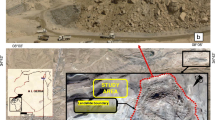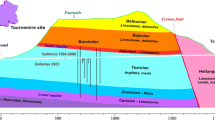Abstract
The main goal of active fault investigation is obtaining evidence of the Quaternary fault activity through trenching. To accomplish this, electrical resistivity surveys are widely utilized to accurately detect faults buried beneath alluvium. In this study, 2D and 3D electrical resistivity surveys were conducted at the Miho site of the southern Yangsan Fault, the Quaternary active fault area already well-studied via trench investigations. The efficacy of electrical resistivity surveys for fault detection was examined by comparing the resistivity distributions against data in the trench logs. At the Miho site, three lines were installed for the 2D electrical resistivity survey and 22 lines were set within a 27 × 27 m square area for the 3D electrical resistivity survey. The length of each survey line was 27 m with an electrode spacing of 1 m. A dipole-dipole array was used to measure the potential difference between each measurement electrode using the same transmitted current and voltage. To derive the 2D and 3D resistivity distributions from the data acquired in the field, the inversion programs DC_2DPRO and DC_3DPRO were employed. Comparison of the 2D resistivity distribution with trench log data shows that the zone of dacitic welded tuff west of the Quaternary fault plane has relatively high resistivity, while the zone of foliate gouge and breccia derived from sedimentary rocks east of the Quaternary fault plane has a low resistivity of less than 40 Ω·m. From these results, it is evident that the method is effective, particularly when different rock types are distributed on either side of the fault boundary or when highly conductive materials, such as clay-rich fault gouges, are present within the fault zone. The resistivity distribution in the 3D survey area can be depicted using both block diagrams and depth-specific slices, facilitating a spatial understanding of the continuity of fault (or fracture) zones. Consequently, this study demonstrates that 3D surveys offer numerous advantages over 2D surveys by accurately capturing planar structures and enabling spatial interpretation based on 3D resistivity distribution.
Similar content being viewed by others
References
Caputo, R., Piscitelli, S., Oliveto, A., Rizzo, E., and Lapenna, B., 2003, The use of electrical resistivity tomographies in active tectonics: examples from the Tyrnavos Basin, Greece. Journal of Geodynamics, 36, 19–35. https://doi.org/10.1016/S0264-3707(03)00036-X
Chang, C.J. and Chang, T.W., 1998, Movement history of the Yangsan Fault based on paleostress analysis. The Journal of Engineering Geology, 8, 35–49. (in Korean with English abstract)
Chang, K.H., Woo, B.G., Lee, J.H., Park, S.O., and Yao, A., 1990, Cretaceous and early Cenozoic stratigraphy and history of eastern Kyongsang basin, S. Korea. Journal of Geological Society of Korea, 26, 471–487. (in Korean with English abstract)
Cheon, Y., Cho, H., Ha, S., Kang, H.-C., Kim, J.-S., and Son, M., 2019, Tectonically controlled multiple deformations along the Yangsan Fault Zone, SE Korea, since Late Cretaceous. Journal of Asian Earth Sciences, 170, 188–207. https://doi.org/10.1016/j.jseaes.2018.11.003
Cheon, Y., Choi, J.-H., Choi, Y., Bae, H., Han, K.-H., Son, M., Choi, S.-J., and Ryoo, C.-R., 2020a, Understanding the distribution and internal structure of the main core of the Yangsan Fault Zone: current trends and future work. Journal of the Geological Society of Korea, 56, 619–640. (in Korean with English abstract) https://doi.org/10.14770/jgsk.2020.56.5.619
Cheon, Y., Choi, J.-H., Kim, N., Lee, H., Choi, I., Bae, H., Rockwell, T.K., Lee, S.R., Ryoo, C.-R., Choi, H., and Lee, T.-H., 2020b, Late Quaternary transpressional earthquakes on a long-lived intraplate fault: a case study of the southern Yangsan Fault, SE Korea. Quaternary International, 553, 132–143. https://doi.org/10.1016/j.quaint.2020.07.025
Choi, J.-H., Kim, Y.-S., and Choi, S.-J., 2015, Identification of a suspected Quaternary fault in eastern Korea: proposal for a paleoseismic research procedure for the mapping of active faults in Korea. Journal of Asian Earth Sciences, 113, 897–908. https://doi.org/10.1016/j.jseaes.2015.09.014
Choi, S., Kim, S.-W., Choi, E.-K., Lee, Y.-C., and Ha, S., 2021, Gravity field interpretation and underground structure modelling as a method of setting horizontal and vertical zoning of a active fault core. Economic and Environmental Geology, 54, 91–103. (in Korean with English abstract) https://doi.org/10.9719/EEG.2021.54.1.91
Choi, S.-J., Ghim, Y.S., Cheon, Y., and Ko, K., 2019, The first discovery of Quaternary fault in the western part of the south Yangsan fault–Sinwoo site. Economic and Environmental Geology, 52, 251–258. (in Korean with English abstract) https://doi.org/10.9719/EEG.2019.52.3.251
Drahor, M.G. and Berge, M.A., 2017, Integrated geophysical investigations in a fault zone located on southwestern part of İzmir city, Western Anatolia, Turkey. Journal of Applied Geophysics, 136, 114–133. https://doi.org/10.1016/j.jappgeo.2016.10.021
Fazzito, S.Y., Rapalini, A.E., Cortes, J.M., and Terrizzano, C.M., 2009, Characterization of Quaternary faults by electric resistivity tomography in the Andean Precordillera of Western Argentina. Journal of South American Earth Sciences, 28, 217–228. https://doi.org/10.1016/j.jsames.2009.06.001
Gu, D., Han, R., and Woo, S., 2021, Geological records of coseismic shear localization along the Yangsan Fault, Korea. Journal of Geophysical Research: Solid Earth, 126, e2020JB021393. https://doi.org/10.1029/2020JB021393
Gwon, O., Son, H., Bae, S., Park, K., Choi, H.S., Kim, Y.-S., and Lee, S.K., 2021, A review on remote sensing techniques and case studies for active fault investigation. Korean Journal of Remote Sensing, 37, 1901–1922. (in Korean with English abstract) https://doi.org/10.7780/kjrs.2021.37.6.2.12
Ha, S., Son, M., and Seong, Y.B., 2022, Active fault trace identification using a LiDAR high-resolution DEM: a case study of the central Yangsan Fault, Korea. Remote Sensing, 14, 4838. https://doi.org/10.3390/rs14194838
Han, J., Nur, A.S., Syifa, M., Ha, M., Lee, C.-W., and Lee, K.-Y., 2021, Improvement of earthquake risk awareness and seismic literacy of Korean citizens through earthquake vulnerability map from the 2017 Pohang Earthquake, South Korea. Remote Sensing, 13, 1365. https://doi.org/10.3390/rs13071365
Hiramatsu, Y., Sawada, A., Kobayashi, W., Ishida, S., and Hamada, M., 2019, Gravity gradient tensor analysis to an active fault: a case study at the Togi-gawa Nangan fault, Noto Peninsula, central Japan. Earth, Planets and Space, 71, 107. https://doi.org/10.1186/s40623-019-1088-5
Hwang, B.-H., Lee, J.-D., Yang, K., and McWilliams, M., 2007a, Cenozoic strike-slip displacement along the Yangsan Fault, southeast Korean Peninsula. International Geology Review, 49, 768–775. https://doi.org/10.2747/0020-6814.49.8.768
Hwang, B.-H., McWilliams, M., Son, M., and Yang, K., 2007b, Tectonic implication of A-type granites across the Yangsan Fault, Gigye and Gyeongju areas, southeast Korean Peninsula. International Geology Review, 49, 1094–1102. https://doi.org/10.2747/0020-6814.49.12.1094
Hwang, H.-S., Hamm, S.-Y., Lee, C.-W., Lee, C.-M., and Kim, S.W., 2017, Application of geophysical methods to determine the extent of the Dongrae Fault in the Oedong-eup area, Gyeongju City. Journal of Engineering Geology, 27, 207–215. (in Korean with English abstract) https://doi.org/10.9720/kseg.2017.3.207
Kim, C.-M., Cheon, Y., Lee, T.-H., Choi, J.-H., Ha, S., and Jeong, J.O., 2022, Long-weakening processes and short-term seismic slip behavior of an intraplate mature fault zone: a case study of the Yangsan Fault, SE Korea. Journal of Geophysical Research: Solid Earth, 127, e2021JB023154. https://doi.org/10.1029/2021JB023154
Kim, J.H., 2009, DC2DPro–2D interpretation system of DC resistivity tomography. User’s Manual and Theory, Korean Institute of Geoscience and Mineral Resources, Daejeon, South Korea, 20 p.
Kim, J.H. and Yi, M.J., 2010, DC3DPRO–3D geoelectrical modelling and inversion. User’s Manual, Korean Institute of Geoscience and Mineral Resources, Daejeon, South Korea, 21 p.
Kim, T., Choi, J.-H., Cheon, Y., Lee, T.H., Kim, N., Lee, H., Kim, C.-M., Choi, Y., Bae, H., Kim, Y.-S., Ryoo, C.-R., and Klinger, Y., 2023, Correlation of paleoearthquake records at multiple sites along the southern Yangsan Fault, Korea: insights into rupture scenarios of intraplate strike-slip earthquakes. Tectonophysics, 854, 229817. https://doi.org/10.1016/j.tecto.2023.229817
Kim, Y.H., Rhie, J., Kang, T.-S., Kim, K.-H., Kim, M., and Lee, S.-J., 2016, The 12 September 2016 Gyeongju earthquakes: 1. Observation and remaining questions. Geosciences Journal, 20, 747–752. https://doi.org/10.1007/s12303-016-0033-x
Kim, Y.-S., Son, M., Choi, J.-H., Choi, J.-H., Seong, Y.B., and Lee, J., 2020, Processes and challenges for the production of Korean active faults map. Journal of the Geological Society of Korea, 56, 113–134. (in Korean with English abstract) https://doi.org/10.14770/jgsk.2020.56.2.113
Ko, K., Choi, S.-J., Lee, T.-H., Gihm, Y.S., Kim, C.-M., Kim, K., and Cheon, Y., 2022, A multidisciplinary approach to characterization of the mature northern Yangsan fault in Korea and its active faulting. Marine Geophysical Research, 43, 21. https://doi.org/10.1007/s11001-022-09486-w
Lee, B.W. and Kim, S.S., 2021, Application of terrestrial LiDAR for reconstructing 3D images of fault trench sites and web-based visualization platform for large point clouds. Economic and Environmental Geology, 54, 177–186. (in Korean with English abstract) https://doi.org/10.9719/EEG.2021.54.2.177
Lee, H., Choi, J.-H., Lee, T.-H., Kim, D.-E., Cheon, Y., Lee, K.S., and Choi, Y., 2023, Detection of fault location and paleoseismic evidence in the cultural heritage site around Gyeongju, SE Korea. Episodes, 46, 521–535. https://doi.org/10.18814/epiiugs/2023/023001
Lee, H.-J., Hamm, S.-Y., Park, S., and Ryoo, C.-R., 2017, Geometric characteristics of southern Yangsan fault zone by means of geophysical prospecting and geological survey. The Journal of Engineering Geology, 27, 9–20. (in Korean with English abstract) https://doi.org/10.9720/kseg.2017.1.9
Meng, F., Zhang, G., Qi, Y., Zhou, Y., Zhao, X., and Ge, K., 2020, Application of combined electrical resistivity tomography and seismic reflection method to explore hidden active faults in Pingwu, Sichuan, China. Open Geosciences, 12, 174–189. https://doi.org/10.1515/geo-2020-0040
Nabi, A., Liu, X., Gong, Z., and Ali, A., 2020, Electrical resistivity imaging of active faults in palaeoseismology: case studies from Karachi Arc, southern Kirthar Fold Belt, Pakistan. NRIAG Journal of Astronomy and Geophysics, 9, 116–128. https://doi.org/10.1080/20909977.2020.1722524
Naik, S.P., Gwon, O., Park, K., Bae, S.Y., Shin, H.-C., Choi, J.-H., and Kim, Y.-S., 2022, Localization and characterization of the southern Ulsan fault (UF) using geo-electrical imaging: implication for seismic hazard assessment in an urbanized area. Journal of Geodynamics, 151, 101919. https://doi.org/10.1016/j.jog.2022.101919
Okada, A., Watanabe, M., Sato, H., Jun, M.S., Jo, W.R., Kim, S.K., Jeon, J.S., Chi, H.C., and Oike, K., 1994, Active fault topography and trench survey in the central part of the Yangsan fault, southeast Korea. Journal of Geography, 103, 111–126. (in Japanese with English abstract)
Park, S.G., Shin, S.W., Lee, D.K., Kim, C.R., and Son, J.S., 2016, Relationship between electrical resistivity and physical properties of rocks. Near Surface Geoscience 2016–First Conference on Geophysics for Mineral Exploration and Mining, Barcelona, Spain, Sep. 4–8, p. 1–5. https://doi.org/10.3997/2214-4609.201602101
Petrit, K., Klamthim, P., and Duerrast, H., 2018, 3D resistivity survey for shallow subsurface fault investigations. E3S Web of Conferences 34, 01007. https://doi.org/10.1051/e3sconf/20183401007
Simyrdanis, K., Papadopoulos, N., and Oikonomou, D., 2021, Computation of optimized electrode arrays for 3-D electrical resistivity tomography surveys. Applied Sciences, 11, 6394. https://doi.org/10.3390/app11146394
Slater, L. and Niemi, T.M., 2003, Ground-penetrating radar investigation of active faults along the Dead Sea Transform and implications for seismic hazards within the city of Aqaba, Jordan. Tectonophysics, 368, 33–50. https://doi.org/10.1016/S0040-1951(03)00149-5
Song, Y., Ha, S., Lee, S., Kang, H.-C., Choi, J.-H., and Son, M., 2020, Quaternary structural characteristics and paleoseismic interpretation of the Yangsan Fault at Dangu-ri, Gyeongju-si, SE Korea, through trench survey. Journal of the Geological Society of Korea, 56, 155–173. (in Korean with English abstract) https://doi.org/10.14770/jgsk.2020.56.2.155
Tassis G., Tsourlos P., and Rønning J.S., 2020, Detection and characterization of fracture zones in bedrock in marine environment: possibilities and limitations. Near Surface Geophysics, 18, 91–103. https://doi.org/10.1002/nsg.12086
Yi, M.-J., Kim, J.-H., and Chung, S.-H., 2003, Enhancing the resolving power of least-squares inversion with active constraint balancing. Geophysics, 68, 931–941. https://doi.org/10.1190/L1581045
Yi, M.-J., Kim, J.-H., Song, Y., Cho, S.-J., Chung, S.-H., and Suh, J.-H., 2001, Three dimensional imaging of subsurface structures using resistivity data. Geophysical Prospecting, 49, 483–497. https://doi.org/10.1046/j.1365-2478.2001.00269.x
Acknowledgments
This study was supported by grants from the Basic Research Projects (GP2020-014 and GP2020-007) of KIGAM, funded by the Korean Ministry of Science and ICT. We appreciate the constructive discussion provided by Dr. Jin-Hyuck Choi. We also gratefully thank Prof. Panos Tsourlos and an anonymous reviewer for very valuable comments, and Prof. Jeong-Sik Oh for editorial guidance.
Author information
Authors and Affiliations
Corresponding author
Additional information
Publisher’s Note Springer Nature remains neutral with regard to jurisdictional claims in published maps and institutional affiliations.
Rights and permissions
About this article
Cite this article
Park, S., Cheon, Y., Yi, MJ. et al. Application of electrical resistivity surveys to detect buried active fault: a case study of the southern Yangsan Fault, Korea. Geosci J (2024). https://doi.org/10.1007/s12303-024-0010-8
Received:
Accepted:
Published:
DOI: https://doi.org/10.1007/s12303-024-0010-8




